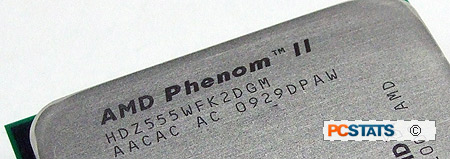 |
| Overclocking Results: |
|
stock |
max. oc |
| processor
speed: |
3.2 ghz |
3.995 ghz |
| multiplier / bus speed: |
16x 200mhz |
17x
235mhz
|
|
oc by
multiplier only |
| processor speed: |
3.2 ghz |
3.92 ghz |
| multiplier / bus speed: |
16x 200mhz |
19.5x 200mhz |
if you're new to
Overclocking and not sure what to do, check out these two excellent
Guides for some pointers:
Overclocking the CPU and Memory
Overclocking the Videocard
| |
AMD Black Edition
processors have a special place in our overclocking hearts thanks to their
unlocked multipliers. An unlocked multiplier opens up a whole world of options,
a chip like the 3.2GHz Phenom II X2 555 Black Edition can be punched up without
increasing the motherboard bus speed one bit!
The Phenom II X2 555 BE CPU is especially interesting
because it's based on AMDs revision C3 silicon, which has PCSTATS crossing its
fingers for some big overclocking numbers from this processor. Will it be able
to hit 4GHz?
As you probably know, overclocking can be accomplished
by adjusting one or two values in an AMD Black Edition processor; the CPU
Multiplier or Motherboard Bus Speed. Mathematically the Phenom II X2 555 Black
Edition's 3.2GHz clock speed is calculated by multiplying its 16x multiplier by
its base 200MHz clock, equaling 3.2GHz (16x200 = 3200MHz). Raising the
multiplier to say, 19x, would result in a 19x 200MHz configuration and an
overclocked CPU speed of 3.8GHz. Simple!
Before we began our overclocking adventures, the Corsair
XMS3-1600C9 memory used in PCSTATS' test system was configured to run in
DDR3-800 MHz mode (from DDR3-1066) so it wouldn't hold the CPU back. With the
socket AM3 Phenom II X2 555 Black Edition chip locked and loaded into Gigabyte's
GA-MA790FXT-UD5P motherboard, we set about overclocking
by Multiplier alone at first.
 Overclocking by CPU
Multiplier
Overclocking by CPU
Multiplier
Starting with the CPU multiplier first (set tp 16x by
default), PCSTATS quickly overclocked AMD's Phenom II X2 555 BE processor by
increasing this value to 16.5x, 17...17.5...18...18.5....19... and finally 19.5x
before the system gave in to instability and BSOD's. PCSTATS tried 20x
multiplier, but the PC barely POSTed before crashing into endless reboots.
Still, with the multiplier set to 19.5x, that resulted in a very nice overclock
from 3.2GHz to 3.92GHz. That's just under the 4GHz we had hoped to achieve.
Overclocking by Motherboard
Bus Speed
Having reset the multiplier back to 16x, PCSTATS set
about overclocking the dual-core Phenom II X2 555BE chip by bus speed alone. And
to make a long story short, the processor was good till 240MHz. That yielded us
an overclocked result of 3.84GHz. For the final round of overclocking tests the
motherboard bus speed and CPU multiplier were both reset to default, and then we
set about overclocking once again. In a matter of minutes the bus was up to
235MHz and multiplier at 17x, resulting an impressive overclock to 3.995GHz. We
tried several combinations of higher bus speed and higher multiplier, but the
PIIX2-555BE just wasn't up for it.
In the end, the maximum overclock result PCSTATS
achieved from the 3.2GHz AMD Phenom II X2 555 BE processor was 17x235MHz =
3.995GHz. That's an increase of 795MHz
from the revision C3 silicon, and a hefty boost in performance! Prelude to Benchmarks
For this review PCSTATS is running the
benchmark suite in both Microsoft Windows Vista and Microsoft Windows 7
operating systems. For the most part, benchmark results are not significantly
different between the two operating systems, although certain tests do see
advantages under Windows 7. Over the
following page we'll be running AMD's 3.2GHz
dual-core AMD Phenom II X2 555 Black Edition processor though PCSTATS standard set of gaming,
productivity, and multi-threaded processor benchmarks. There are a wide variety
of gaming and synthetic benchmarks here to illustrate what kind of performance
boost users can expect from the latest quad-core socket AM3 AMD processor.
Please take a moment to look over PCSTATS test system configurations before
moving on to the individual benchmark results on the next several
pages.
